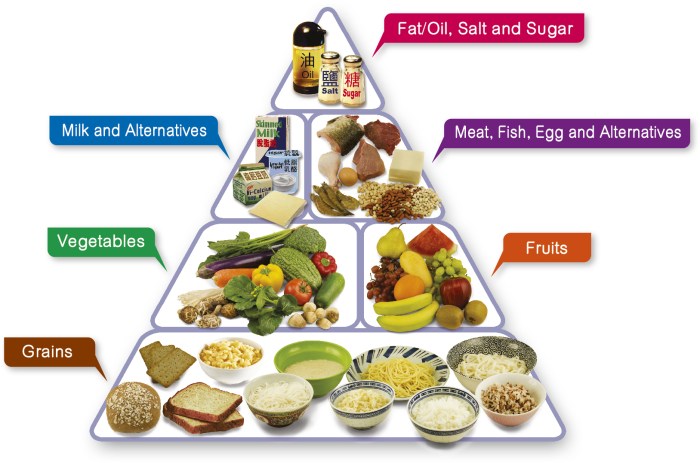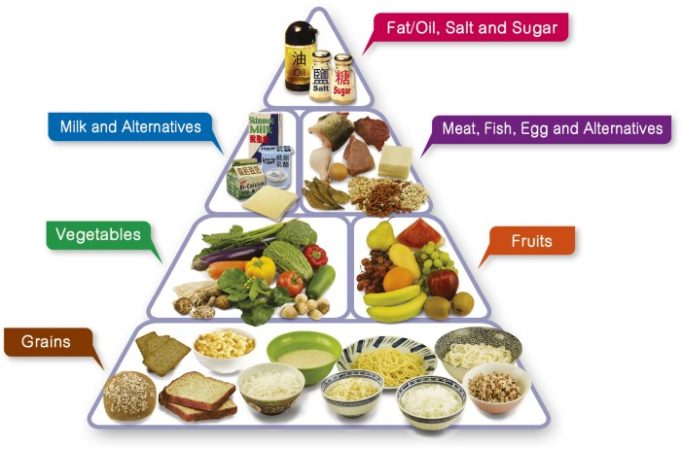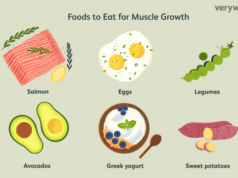Recommended Dietary Intake, or RDI, is a cornerstone of nutrition, providing a framework for achieving optimal health through food. It Artikels the specific amounts of essential nutrients needed daily to maintain well-being, taking into account factors like age, gender, and lifestyle.
The concept of RDI has evolved over time, reflecting advancements in scientific understanding of nutrition and the impact of dietary choices on health. This comprehensive guide explores the components of RDI, the factors influencing individual needs, and the vital link between meeting these recommendations and achieving optimal health.
Defining Recommended Dietary Intake (RDI)
The Recommended Dietary Intake (RDI) is a vital tool for maintaining optimal health and preventing nutrient deficiencies. It provides guidelines on the amount of essential nutrients individuals should consume daily to meet their physiological needs. Understanding RDI is crucial for individuals, healthcare professionals, and policymakers to make informed dietary choices and promote public health.
Historical Evolution of RDI Guidelines
RDI guidelines have evolved over time, reflecting advancements in nutritional science and understanding of human health. Early dietary recommendations were primarily based on preventing deficiency diseases, such as scurvy and rickets. However, as scientific knowledge expanded, the focus shifted to promoting overall health and preventing chronic diseases linked to diet.
The concept of RDI originated in the early 20th century, with the establishment of the Recommended Daily Allowances (RDAs) in the United States. These guidelines were initially developed to address wartime food rationing and ensure adequate nutrient intake for the population.
Over the years, the RDAs have been revised and expanded to include a wider range of nutrients and consider factors such as age, gender, and life stage. The Dietary Reference Intakes (DRIs), a broader set of nutrient recommendations, were introduced in the 1990s. The DRIs encompass a range of values, including the RDI, Estimated Average Requirement (EAR), Adequate Intake (AI), and Tolerable Upper Intake Level (UL). These values provide a comprehensive framework for dietary planning and guidance.
Variations in RDI Based on Individual Factors
The RDI for various nutrients varies based on several factors, including age, gender, and lifestyle. These variations reflect the different physiological needs and demands of individuals at different life stages.
Age
- Infants and young children require higher amounts of certain nutrients, such as iron and vitamin D, to support their rapid growth and development.
- Older adults may have different nutrient requirements due to age-related changes in metabolism and absorption.
Gender
- Men generally require more calories and certain nutrients, such as iron, than women, due to their larger muscle mass and higher metabolic rate.
- Women of childbearing age have specific nutrient requirements, particularly for iron and folate, to support pregnancy and breastfeeding.
Lifestyle Factors
- Pregnant and breastfeeding women have increased nutrient needs to support fetal growth and milk production.
- Athletes and highly active individuals require higher calorie and nutrient intakes to meet their energy demands and support muscle recovery.
- Individuals with specific health conditions, such as diabetes or heart disease, may have modified dietary recommendations to manage their condition.
Components of RDI
The Recommended Dietary Intake (RDI) is a guideline for the amount of nutrients that individuals need to consume daily to maintain good health. It is important to note that the RDI can vary depending on factors such as age, sex, activity level, and health conditions. The RDI is typically divided into two main categories: macronutrients and micronutrients.
Macronutrients
Macronutrients are nutrients that the body needs in large amounts. They provide the body with energy and are essential for growth, development, and overall health. The three main macronutrients are carbohydrates, proteins, and fats.
| Macronutrients | Recommended Daily Intake | Functions in the Body | Deficiency Symptoms |
|---|---|---|---|
| Carbohydrates | 45-65% of total daily calories | Provide energy, spare protein from being used as fuel, and help with the absorption of certain nutrients. | Fatigue, weakness, dizziness, headaches, and difficulty concentrating. |
| Proteins | 10-35% of total daily calories | Build and repair tissues, produce enzymes and hormones, and help with immune function. | Muscle loss, weakness, fatigue, and impaired immune function. |
| Fats | 20-35% of total daily calories | Provide energy, insulate organs, and help with the absorption of certain vitamins. | Dry skin, hair loss, and impaired brain function. |
Carbohydrates are the body’s primary source of energy. They are broken down into glucose, which is used by the body’s cells for fuel. The RDI for carbohydrates is 45-65% of total daily calories. This means that if you consume 2,000 calories per day, you should aim to get 900-1,300 calories from carbohydrates.
Proteins are essential for building and repairing tissues, producing enzymes and hormones, and helping with immune function. They are made up of amino acids, which the body cannot produce on its own. The RDI for protein is 10-35% of total daily calories. This means that if you consume 2,000 calories per day, you should aim to get 200-700 calories from protein.
Fats are an important source of energy and help to insulate organs and absorb certain vitamins. They are also essential for cell function and hormone production. The RDI for fats is 20-35% of total daily calories. This means that if you consume 2,000 calories per day, you should aim to get 400-700 calories from fats.
Micronutrients
Micronutrients are nutrients that the body needs in small amounts. They play a vital role in maintaining health and preventing disease. The two main categories of micronutrients are vitamins and minerals.
Vitamins are organic compounds that the body needs in small amounts. They are essential for a variety of functions, including energy production, cell growth and repair, and immune function.
Minerals are inorganic substances that the body needs in small amounts. They are essential for a variety of functions, including bone health, muscle function, and nerve function.
Factors Influencing RDI

The Recommended Dietary Intake (RDI) is not a one-size-fits-all guideline. It’s tailored to meet the unique needs of individuals based on various factors. These factors play a crucial role in determining the specific amounts of nutrients an individual requires for optimal health.
Individual Needs and RDI
Several factors influence an individual’s RDI. These include:
- Age: As we age, our nutritional needs change. For instance, children and adolescents require higher intakes of certain nutrients, such as calcium and iron, to support their growth and development. Older adults, on the other hand, may have different needs due to age-related changes in metabolism and absorption.
- Gender: Men and women have different RDI recommendations for certain nutrients, such as iron. This is due to physiological differences, such as menstrual cycles in women.
- Pregnancy and Lactation: During pregnancy and lactation, a woman’s nutritional needs increase significantly to support the growth and development of the fetus and infant. Therefore, pregnant and lactating women have higher RDIs for essential nutrients like folate, iron, and calcium.
- Health Status: Individuals with certain health conditions, such as diabetes, heart disease, or kidney disease, may require modified RDIs to manage their condition. For example, individuals with diabetes may need to adjust their carbohydrate intake.
- Physical Activity Level: Athletes and individuals engaging in regular strenuous exercise have higher energy and nutrient requirements than sedentary individuals. This is because their bodies need more fuel to support their increased physical activity.
- Lifestyle Factors: Smoking, alcohol consumption, and stress can impact nutritional needs. For instance, smokers may require higher vitamin C intake due to its antioxidant properties.
- Genetic Factors: Some individuals may have genetic predispositions that influence their nutrient requirements. For example, individuals with certain genetic variants may have difficulty absorbing certain nutrients.
RDI for Specific Groups
The RDI guidelines are adjusted to cater to the unique needs of different population groups.
Athletes
Athletes have increased energy and nutrient requirements due to their high physical activity levels. They need more calories, carbohydrates, and protein to fuel their training and performance. Athletes also need to pay attention to their intake of electrolytes, such as sodium and potassium, which are lost through sweat.
Pregnant Women
During pregnancy, a woman’s body undergoes significant changes to support the growth and development of the fetus. This requires increased nutrient intake, particularly for folate, iron, calcium, and vitamin D. These nutrients are essential for fetal growth, brain development, and bone health.
Older Adults
As we age, our bodies become less efficient at absorbing and utilizing nutrients. Older adults may also experience changes in appetite and food preferences, which can affect their dietary intake. They may require higher intakes of certain nutrients, such as vitamin D, calcium, and vitamin B12, to maintain bone health, cognitive function, and energy levels.
Dietary Restrictions and RDI
Individuals following dietary restrictions, such as vegetarianism or veganism, need to pay close attention to their nutrient intake to ensure they meet their RDIs.
Vegetarianism
Vegetarians exclude meat from their diet but may consume dairy products and eggs. While vegetarian diets can be healthy, individuals need to ensure they consume adequate amounts of protein, iron, vitamin B12, and calcium, which are often found in animal products.
Veganism
Vegans exclude all animal products from their diet, including meat, dairy, and eggs. Vegan diets can be nutritionally complete, but individuals need to be mindful of their intake of protein, iron, vitamin B12, calcium, and omega-3 fatty acids. These nutrients are found in plant-based foods, but it may be necessary to supplement to meet the RDIs.
RDI and Health Outcomes
Meeting the Recommended Dietary Intake (RDI) for essential nutrients is crucial for maintaining optimal health and well-being. When individuals consume the right amount of nutrients, their bodies can function properly, reducing the risk of developing various health problems.
Impact of Meeting RDI on Overall Health
Adequate nutrient intake plays a vital role in supporting various bodily functions, including:
* Energy production: Nutrients like carbohydrates, fats, and proteins provide the energy needed for daily activities.
* Growth and development: Essential nutrients like vitamins and minerals are crucial for growth, development, and cell repair.
* Immune system function: A balanced diet strengthens the immune system, making the body more resistant to infections and diseases.
* Hormone production: Certain nutrients are essential for the production of hormones that regulate various bodily processes.
* Mental health: Nutrients like omega-3 fatty acids and B vitamins play a role in brain function and mental well-being.
Health Risks Associated with Exceeding or Falling Short of RDI
Both exceeding and falling short of the RDI for specific nutrients can lead to adverse health consequences.
Exceeding RDI
Consuming excessive amounts of certain nutrients can lead to various health problems:
* Obesity: Excess calorie intake from carbohydrates, fats, and sugars can lead to weight gain and obesity.
* Cardiovascular disease: High intake of saturated and trans fats can increase the risk of heart disease.
* Kidney stones: Excessive intake of calcium, sodium, and oxalate can contribute to the formation of kidney stones.
* Nutrient toxicity: Consuming excessive amounts of certain vitamins and minerals can lead to toxicity, resulting in various health issues.
Falling Short of RDI
Inadequate nutrient intake can also lead to various health problems:
* Malnutrition: Insufficient intake of essential nutrients can lead to malnutrition, resulting in weakness, fatigue, and impaired growth and development.
* Anemia: Iron deficiency can lead to anemia, characterized by fatigue, shortness of breath, and pale skin.
* Osteoporosis: Calcium deficiency can increase the risk of osteoporosis, a condition characterized by weak and brittle bones.
* Impaired immune function: Vitamin deficiencies can weaken the immune system, making the body more susceptible to infections.
Relationship Between Specific Nutrients and Associated Health Conditions
The table below illustrates the relationship between specific nutrients and their associated health conditions:
| Nutrient | Health Conditions Associated with Deficiency | Health Conditions Associated with Excess |
|---|---|---|
| Iron | Anemia | Iron overload, hemochromatosis |
| Calcium | Osteoporosis, rickets | Kidney stones, hypercalcemia |
| Vitamin D | Rickets, osteomalacia | Hypercalcemia, kidney stones |
| Vitamin A | Night blindness, xerophthalmia | Hypervitaminosis A |
| Iodine | Hypothyroidism, goiter | Hyperthyroidism |
| Zinc | Growth retardation, impaired immune function | Zinc toxicity |
| Sodium | Hyponatremia | Hypertension, edema |
Practical Applications of RDI
The Recommended Dietary Intake (RDI) is not just a set of numbers on a chart; it’s a practical tool that can guide individuals towards healthier eating habits. RDI serves as a blueprint for making informed food choices, promoting overall well-being, and preventing nutritional deficiencies.
Food Labeling and Nutrition Education
Food labeling utilizes RDI to provide consumers with valuable information about the nutrient content of packaged foods. This information empowers consumers to make informed decisions about their dietary choices. For instance, the “% Daily Value” (DV) on food labels represents the percentage of the RDI for a particular nutrient provided by a single serving of the food. This helps consumers compare different food options and understand how much of a specific nutrient they are consuming.
Resources for Personalized Dietary Guidance, Recommended dietary intake
Individuals seeking personalized dietary guidance can benefit from consulting with registered dietitians or nutritionists. These professionals are equipped to assess an individual’s dietary needs and provide tailored recommendations based on RDI and other relevant factors.
- Registered Dietitians (RDs): RDs are qualified healthcare professionals who provide evidence-based dietary advice and counseling. They can help individuals create personalized meal plans based on their RDI, health conditions, and lifestyle preferences.
- Nutritionists: While not all nutritionists are registered dietitians, many possess extensive knowledge about nutrition and can offer valuable dietary guidance. They can assist individuals in understanding their RDI and making informed food choices.
- Online Resources: Reputable websites and apps provide information about RDI and personalized meal planning tools. These resources can be helpful for individuals who want to learn more about their dietary needs and explore different food options.
Incorporating RDI into Daily Meal Planning
Integrating RDI into daily meal planning is a key step towards achieving optimal health and well-being. Here are some tips to incorporate RDI into your daily food choices:
- Focus on Variety: Include a wide range of foods from all food groups to ensure you’re meeting your RDI for various nutrients.
- Prioritize Whole Foods: Choose whole, unprocessed foods like fruits, vegetables, lean protein sources, and whole grains. These foods are naturally rich in essential nutrients.
- Read Food Labels: Pay attention to the “% Daily Value” on food labels to understand the nutrient content of the foods you consume. This can help you make informed choices and ensure you’re meeting your RDI.
- Plan Meals in Advance: Preparing meals ahead of time can help you make healthier choices and stick to your dietary goals. Consider meal prepping or planning your meals for the week.
- Stay Hydrated: Drink plenty of water throughout the day to support overall health and well-being.
Conclusive Thoughts
By understanding and applying the principles of recommended dietary intake, individuals can empower themselves to make informed food choices that support their overall well-being. From balancing macronutrients to incorporating a diverse range of micronutrients, adhering to RDI guidelines can contribute to a healthier, more fulfilling life.
Q&A: Recommended Dietary Intake
What are the potential consequences of not meeting RDI?
Not meeting RDI can lead to various health issues, including nutrient deficiencies, weakened immune function, increased risk of chronic diseases, and fatigue.
Can I rely solely on dietary supplements to meet RDI?
While supplements can play a role, they should not replace a balanced diet. Aim to meet your RDI through whole foods whenever possible.
How often should RDI guidelines be updated?
RDI guidelines are periodically reviewed and updated by health organizations based on new scientific research and evolving dietary recommendations.
Sticking to a recommended dietary intake is crucial for overall health, but it’s especially important for those with conditions like hypothyroidism. If you’re dealing with this condition, you might find it helpful to learn about how to treat hypothyroidism with diet , as specific foods can help manage symptoms and support your overall well-being.
Remember, it’s always a good idea to consult with a healthcare professional for personalized advice on managing your dietary intake.
Sticking to a recommended dietary intake is crucial for maintaining good health. However, many people wonder if certain food and drink choices can negatively impact their health. One such question is, can diet soda cause diabetes ? While research continues, it’s important to remember that overall dietary patterns and lifestyle choices play a much larger role in managing diabetes than any single beverage.
Sticking to a recommended dietary intake can be challenging, especially on a tight budget. Fortunately, there are many affordable options available, and you can find some great ideas for cheap diet meals online. By planning your meals and making smart choices at the grocery store, you can easily maintain a healthy and balanced diet without breaking the bank.
























